Draba grayana
Revis. Drabas W. N. Amer., 29. 1941.
Perennials; (densely cespitose); caudex branched (covered with persistent, somewhat thickened, dry petioles); not scapose. Stems unbranched, 0.08–0.6 dm, densely to moderately pubescent throughout, trichomes simple and stalked, 2- or 3-rayed, 0.2–1 mm. Basal leaves rosulate; petiolate; petiole ciliate, (trichomes simple, 0.2–1 mm); blade linear to linear-oblanceolate, (0.4–)0.6–1.5(–2) cm × 1–2 mm, margins entire, (pubescent as petiole), surfaces pubescent abaxially with simple and stalked, 2- or 3-rayed trichomes, 0.1–0.4 mm, adaxially glabrate or subapically sparsely pubescent with simple trichomes. Cauline leaves 1–4; sessile; blade linear to linear-oblanceolate, margins entire, surfaces pubescent as basal. Racemes 5–12(–16)-flowered, usually ebracteate, rarely proximalmost flowers bracteate, slightly elongated in fruit; rachis not flexuous, pubescent as stem. Fruiting pedicels divaricate-ascending, straight or slightly curved upward, 1.5–6 mm, pubescent as stem. Flowers: sepals ovate, 1.5–2 mm, pubescent, (trichomes simple and short-stalked, 2- or 3-rayed); petals bright yellow, spatulate, 3–4.5 × 1–2 mm, (flared, clawed); anthers ovate, 0.3–0.5 mm. Fruits lanceolate to oblong-lanceolate, slightly twisted or plane, flattened, 4–12 × 1.5–3 mm; valves glabrous or pubescent, trichomes simple, 0.07–0.2 mm; ovules 16–20 per ovary; style 0.4–1.2 mm. Seeds ovoid, 1–1.4 × 0.7–1 mm. 2n = 24 ± 3.
Phenology: Flowering Jul–Aug.
Habitat: Alpine tundra, fellfields, gravelly wet meadows
Elevation: 3500-4000 m
Discussion
Of conservation concern.
Draba grayana is an apomictic species clearly related to D. exunguiculata, with which it is occasionally sympatric (see discussion of 36. D. exunguiculata for distinguishing features). It is known from Chaffe, Clear Creek, Larimer, Park, and Summit counties.
Selected References
None.
